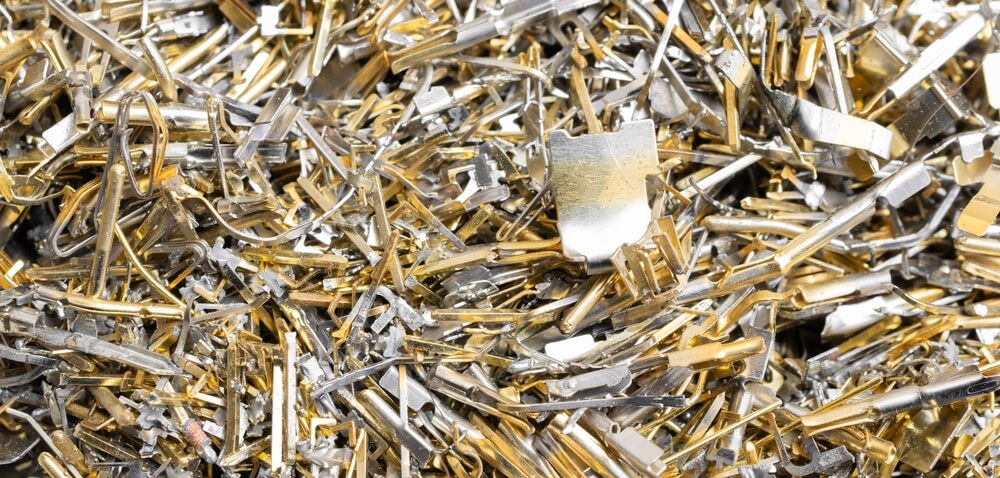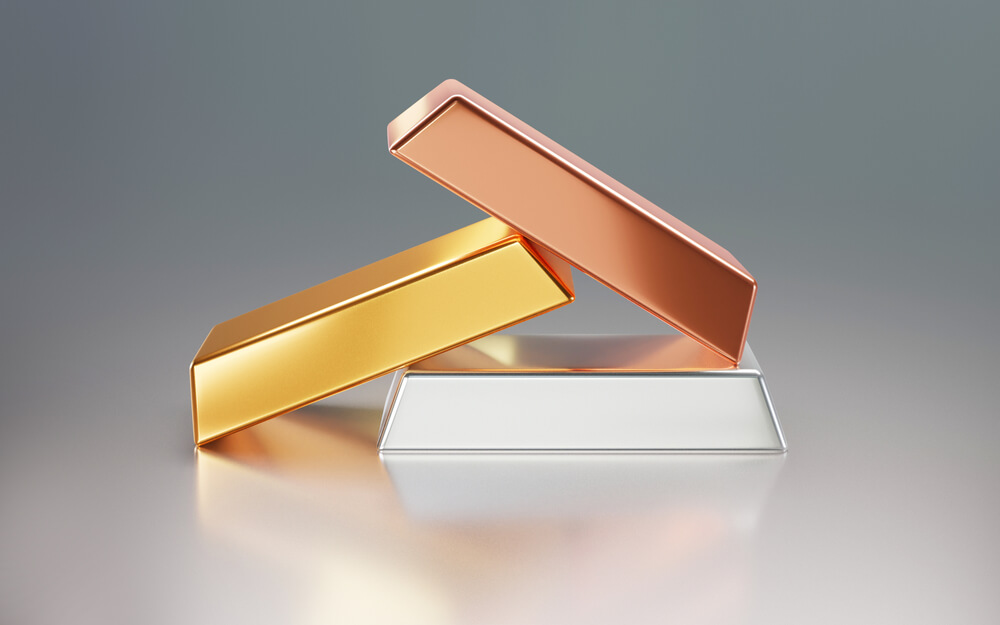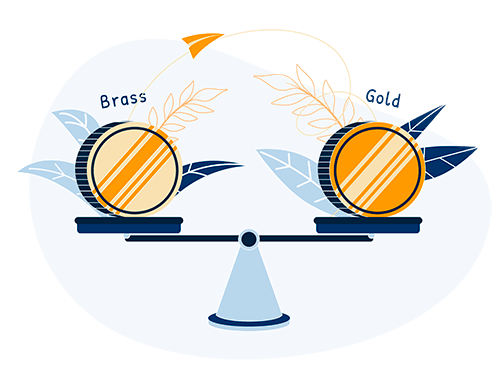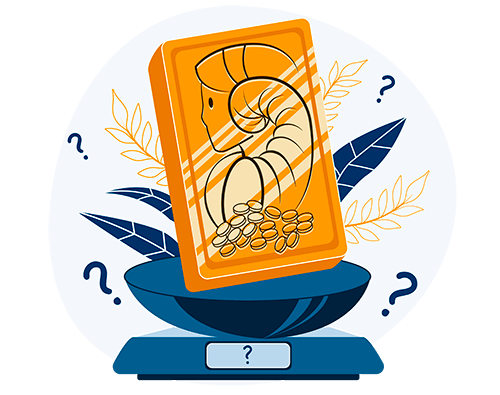
Precious Metal Trends: Is Platinum More Valuable Than Gold?
Fifty years denote a “golden anniversary.” A diamond jubilee is 60 years, and a “platinum anniversary” represents 70 years. By this logic, gold sits below diamond and platinum. What does that say about the significance of the respective precious commodities in the real world?

Diamond is not a metal; it’s a stone. Platinum and gold are precious metals and are interchangeable in several applications. Gold is used to make jewelry, bullion coins, industrial tools, etc. Platinum jewelry, platinum coins and bars, etc., exist too.
Table of Contents
Platinum, however, isn’t as widespread in use as gold is. Does that mean it’s rarer than gold? If it is, is platinum more valuable than gold? If not, why is it usually placed in an echelon above gold? Let’s find the answers to the questions.
Read more: Top Gold IRA companies
In this article, we’ll cover the following:
- An introduction to platinum, the metal
- Its significance and uses
- How it compares to gold on various parameters
- Answers to some common questions and more
For many, gold is the most valuable among precious metals. On paper, however, platinum is deemed the more coveted. There’s clearly a lot of contradiction and confusion regarding the two. Read on to get a complete low-down and clear-cut view of how the two stack up.
P.S. The focus here will be primarily platinum. References will be made to gold to gain some context. Please read our other guides if you’d like to learn about gold and gold investments.
Platinum: A Brief Intro

Platinum is a shiny, silvery-white precious metal. The metal is highly resistant to corrosion and tarnishing yet soft and malleable. It’s a lot like gold physically but it is not the same. Platinum is dense, clocking 12.4 ounces a cubic inch. It was once called “white gold.” That status changed when people started manufacturing white gold by mixing gold with other costly metals. Platinum is a member of the “transition metals” clan that comprises gold, titanium, copper, etc.
When the Spaniards first discovered the metal in Colombia (Central America), they dismissed it as an impure or sub-par variant of silver. They named it “platina,” meaning “little silver,” which is also where the current name came from. Currently, close to 80 percent of the global platinum production is in South Africa. The second-largest miner is Russia, accounting for 10 percent of the output. The remainder is courtesy of platinum mining carried out in South and North America, China, etc.
Is Platinum More Valuable Than Gold?
If we consider the current prices of the two, platinum is undoubtedly cheaper than gold. Platinum (as of March 2023) trades for approximately $965 an ounce. Gold’s price is above $1,900.
Years ago, platinum traded for more than gold per troy ounce. In 2013, platinum cost around $1,700 per ounce. Gold price was $1,690. That is when industries started to bounce back from the subprime mortgage crisis hit. Between 1987 and September 2008, platinum traded for more than gold due to robust industrial activity.
If gold and platinum prices are on the same plane, that indicates healthy industrial activity. When gold prices rally and platinum falls, that’s typically lowered economic certainty. In 2011, gold prices were much higher than platinum as economies were still reeling from the financial blow meted by the Great Recession.
Platinum: Significance/Applications
Like gold, platinum has multiple applications. Here are some common ways in which the pure metal is employed:
Automobiles
Platinum is commonly used in modern industries. Car manufacturers use platinum in their automobiles’ catalytic converters. In fact, more than 50 percent of platinum demand in the industry space is for catalytic converter use in buses, trucks, cars, etc. Platinum is quite adept at converting hazardous engine emissions into waste that’s harmful to a lesser extent. The converter’s catalyst component could also use palladium and rhodium. The three metals belong to the platinum group metal (PGM) clan, which also comprises ruthenium, osmium, and iridium. The six durable metals are known for their excellent catalytic capabilities.
Other Industries
Besides the auto industry, platinum helps make medical devices, aircraft components, electronic parts, etc. Chemotherapy drugs, lab equipment, thermometers, electrodes, dental fillings, and pacemakers may contain platinum compounds. The electronics industry also has multiple platinum applications—such as in computer hard disks. Platinum holds up well in high temperatures. It boasts stable electrical traits and has increased resistance to chemical attacks.
Jewelry and Bullion
As mentioned above, platinum is not the most commonly used metal in jewelry, particularly when you compare platinum to gold. But you should not be hard-pressed to find platinum jewels, particularly a wedding or engagement ring. Regarding bullion bars and coins, several foundries make platinum bars in varied sizes (1 kg, 10 oz, 1 oz, etc.). Platinum coins are not minted in significant numbers but are still pretty veritable investment vehicles.
Gold and Platinum: A Comparison
Several factors determine the price differences between the two premium metals. Here are ways in which platinum differs or is not the same as gold:
Platinum Lacks History and Allure
Compared to gold, platinum has a minimal history. It wasn’t used during ancient civilizations to mint coins, primarily because it’s difficult to locate. Platinum came to the forefront only during the 18th century. Gold was several centuries old and familiar by then. The lengthy history has helped create a strong cultural link between wealth and gold, which continues to date.
Platinum doesn’t look very different from steel or silver. To put it bluntly, the three are just different shades of metallic white. On the other hand, gold has a unique color and an attractive shimmer. Because platinum looks similar to white metals such as silver, it was usually mistaken for those metals, causing it to remain low-profile for decades.
Platinum is More “Industrial” of the Two
Industrial activity primarily determine platinum prices. The jewelry market or individuals primarily ascertain gold prices. The more the demand for gold among individual gold buyers, the higher its market value. When industry activity slumps, platinum demand goes down, and its prices take a hit. On the contrary, people throng on gold during an economic crisis. Although gold has applications outside jewelry, it’s not as widely used in industries as platinum. Silver and copper, comparatively, are a lot more “industrial.”
Platinum is More Volatile
Of all precious metals, platinum prices fluctuate the most and don’t stabilize well. Industrial demand and production in Russia and South Africa are two major factors. The price of platinum hit its nadir in 2008, trading at $2,250 an ounce. The prices plummeted to $777 in the next six months and have not come closer to 2008. Gold, in contrast, is more reliable and stable.
Platinum Resale Value Isn’t the Best
Although platinum is a precious metal and a store of value, it’s not found in the cupboards and vaults of private buyers as commonly as gold. In other words, there aren’t as many buyers for platinum in the secondary market as for gold. Platinum is not as liquid as gold. Gold is viewed more as currency without counterparty risk. Platinum fares relatively poorly during a financial crisis.
Since the retail demand isn’t the greatest, most platinum jewel or bullion owners wanting to sell their items will be hard-pressed to find a genuinely willing buyer. Jewelers or expensive metal dealers look to snag platinum from the secondary market for cheap owing to the comparatively less demand.
Platinum is Heavier, Harder
Platinum is a more durable metal than gold. On the Mohs scale, gold’s hardness is 2.5 to 3. Platinum’s score is 4 to 4.5. The higher the number, the more durable and rugged the material. Platinum’s durability and toughness are one of the major reasons it’s hard to work with. But the rigidity lends platinum increased scratch resistance. Also, platinum’s melting point of 1,768 °C (3,214.4 °F) is higher than gold’s 1064.18 °C (1,947 °F), which also indicates platinum is harder than gold and shaping and molding it is difficult.
Gold and platinum are different on the malleability and ductility fronts too. A metal’s malleability denotes the ability to assume different shapes without breaking or cracking. “Ductility,” on the other hand, is the innateness to be drawn out or stretched into a thin cord without breaking or snapping. Gold is a lot more malleable, whereas platinum is more ductile.
Platinum is a Soft Metal
Even though platinum is harder or denser than gold, it’s still not strong enough for pure platinum jewels. Like gold, platinum is usually mixed with other valuable metals, such as ruthenium and iridium, to make jewelry and other aesthetic pieces. The presence of other metals is generally lesser than gold and could be anywhere between 5 and 20 percent or greater.
For instance, 950 platinum jewel denotes a piece that’s 95 percent platinum and 5 percent other premium metals. 900, 850, and 800 platinum imply the article has 10, 15, and 20 percent other metals, respectively. A hallmark sign usually indicates a platinum jewel’s purity levels.
Note that the different metals used help accentuate platinum’s characteristic white color. Unlike gold jewelry, there’s no effort or intention to alter or tinker with the look or color of a platinum piece. For instance, like rose gold, there’s no pink or rose platinum.
Platinum is Rarer Than Gold
Platinum is rare. It’s found in a few regions, such as South Africa and Russia. In 2022, close to 190 metric tons of platinum were mined. That’s significantly low compared to the 3,000 metric tons of gold procured in 2021. The rarity is due to the limited resources and the difficulty attached to mining platinum, as the metal is much deeper than gold in the earth’s crust. Platinum is usually found accidentally or when mining for other expensive metals. It’s so rare that trying to discover new platinum is not cost-efficient.
Platinum Drives Portfolio Growth
Experts usually recommend that a balanced investment portfolio has no more than 10 percent in gold assets. Ten percent is the maximum. That’s because gold is primarily a wealth-safeguarding asset. It offers no returns (interests or dividends), and capital gains are relatively low because prices don’t move as vehemently as traditional stocks.
Platinum has a different investment profile. Because there’s more platinum used in industries than gold, its prices go up and down significantly, similar to stocks. Platinum is, therefore, a good investment who’d like to purchase a premium metal with growth prospects and are not averse to risks.
| Parameters | Platinum | Gold |
| Liquidity | Low trading volume | High trading volume |
| Price stability | More prone to price swings, thanks to its predominant use in industries | Fluctuates but is more stable overall |
| Applications | Industrial, automobiles, manufacturing, jewelry, etc. | Jewelry, computers, arts, medicine, etc. |
| Price per ounce as of March 2023 | $975 | $1,985 |
Gold or Platinum: What to Invest In?
Both gold and platinum are solid investment metals. You can buy them as bullion bars or coins from coin dealers, brokerages, precious metal dealers, banks, etc. The two purest precious metals are also available for investing in stocks. However, platinum’s presence in the stocks and mutual funds market isn’t as robust as gold. Also, you’ll find fewer platinum bars and coins than their gold counterparts.
Note that the two don’t serve the same investment objectives or purposes. Gold is a better investment option if you’re seeking stability and holding the money in the metal for the long term. Gold’s history of demand and equilibrium is much superior to platinum’s. Platinum is a solid metal to invest in during economic growth. When industries boom, especially the manufacturing sector, platinum prices also rally. But because platinum is volatile, it’s more suited for short-term investing strategies. Platinum investments’ value lies in their volatility.
If you buy and sell platinum at the right time, you will make decent trading gains. But if you hold on to platinum for too long, you will likely incur losses. You need a greater risk tolerance when investing in platinum.
Read more: Best gold IRA companies
Conclusion
Gold and platinum are both intrinsically valuable precious metals. However, gold is usually the pricier of the two metals since it’s more stable and reliable on the price front. Platinum, on the other hand, is very volatile or vulnerable to externalities. Gold prices fluctuate too. But you’ll seldom see gold prices hitting the lows from years ago. The price of platinum, on the other hand, can drop to the price it was trading a decade ago. That is mainly why platinum trades for less than gold and has been like that for years.
FAQs
Does platinum have intrinsic value?
Yes, platinum is intrinsically valuable, just like gold. The aspects contributing to platinum’s value are its rarity or more demand than supply, physical attributes such as resistance to corrosion and high melting point, perceived value, etc.
What is the difference between platinum and white gold?
Platinum and white gold look almost identical but are not the same. White gold jewelry is often considered an inexpensive alternative to platinum. Platinum is a naturally shiny white metal. White gold is pure gold mixed with nickel, silver, palladium, or other white metals and plated with rhodium to achieve the platinum-like appearance.
Both platinum and white gold wear over time. Depending on the rhodium coating’s thickness, white gold will reveal its innards and look slightly yellowish. Unlike white gold, no amount of wear will degrade platinum’s naturally white look. Over a period, platinum jewels shall assume a satiny or patina finish. It’s a sign of wear and tear, which several platinum aficionados desire.
When should you invest in gold and platinum?
Because gold prices increase during a recession and platinum value sinks in the same period, buying gold when the economy is doing well is recommended. Contrarily, buy platinum when the industry is struggling.
Why are platinum rings so popular?
Platinum rings are more sought after than gold rings for weddings or engagements due to their increased durability. Gold prongs break easily compared to platinum. Also, some people like platinum for its look and finish. White gold emulates that, but its rhodium plating fades over time, needing retouches or replacements. A platinum ring, therefore, is also more suitable for everyday wear. And then there’s personal preference too.
Some people are also sensitive to white gold or develop allergic reactions due to the nickel and, therefore, usually, opt for a platinum ring. Also, platinum pairs better with diamonds than yellow gold. A platinum base with a diamond pedestal looks splendid on any finger. All these aspects combine to make platinum engagement or wedding rings more sought after and, therefore, pricier.


